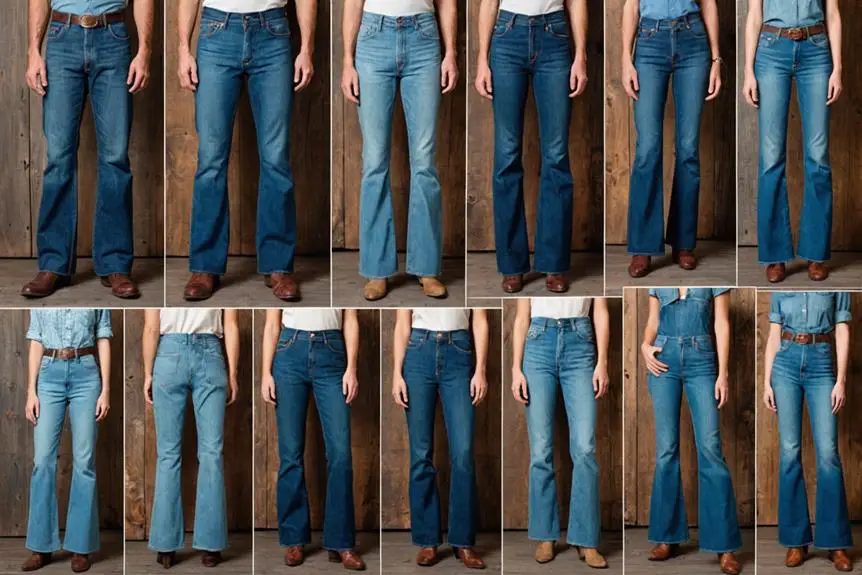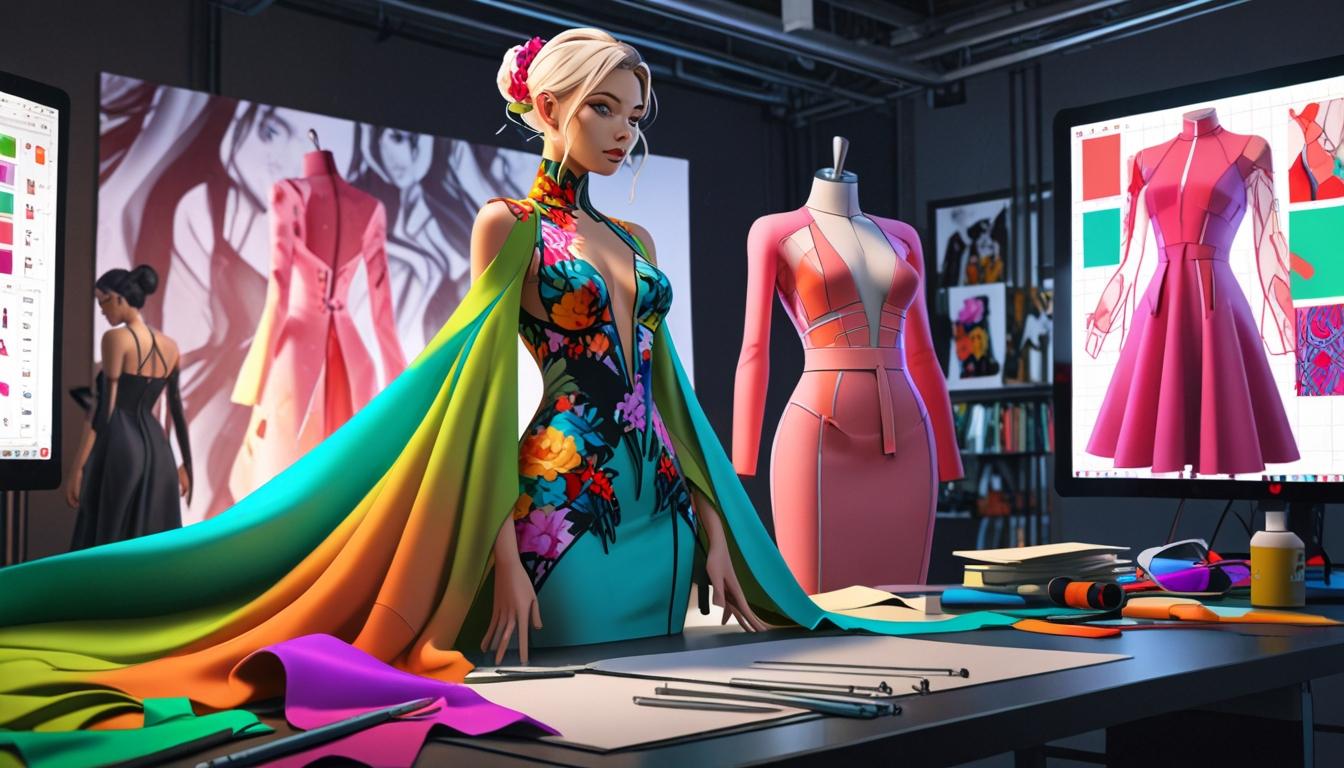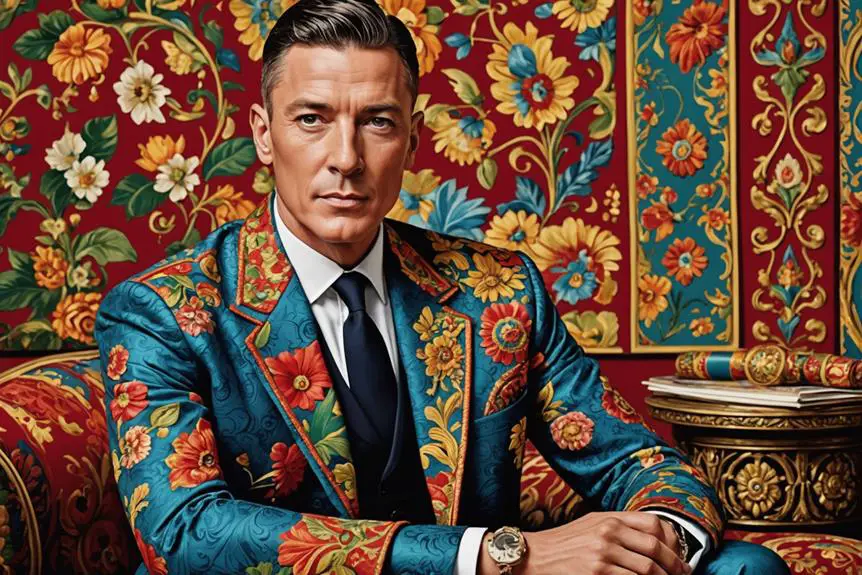When you think about jeans, you probably picture a versatile wardrobe staple, but their origins are far more intriguing. You might not know that denim traces back to 17th century France, evolving into the workwear that Levi Strauss famously popularized in the 1870s. As jeans shifted from laborers' uniforms to symbols of cultural movements, they reflected societal changes in ways you may not have considered. What drove these transformations, and how did jeans become a canvas for personal expression? Exploring these questions reveals a rich narrative that continues to shape fashion today.
Origins of Denim
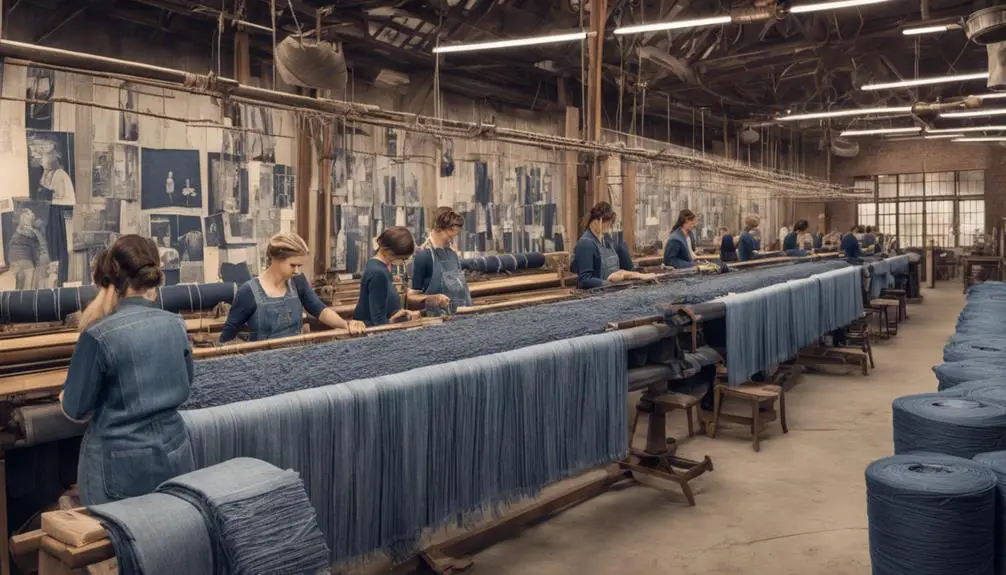
Denim's journey began in the late 17th century in Nîmes, France, where artisans crafted a sturdy cotton twill fabric known as "serge de Nîmes." This term translates to "twill from Nîmes," highlighting its origins. The fabric quickly gained popularity, especially among sailors from Genoa, Italy, who referred to it as "jeans." This durable material was ideal for work clothes, thanks to its strength and resilience. The evolution of denim is not only tied to its functional qualities but also to significant cultural shifts, as brands like Lee emerged to cater to changing consumer preferences and styles, showcasing their vintage Lee logo variations.
The unique blue color of denim comes from indigo dye, sourced from the leaves of the Indigofera tinctoria plant, a practice that dates back thousands of years. As the fabric evolved, it caught the attention of innovators like Levi Strauss and Jacob Davis. On May 20, 1873, they patented riveted denim work pants, forever changing the landscape of fashion with the birth of blue jeans.
As decades passed, denim progressed from essential workwear to a beloved fashion staple, particularly in the 1950s when Hollywood and youth culture embraced its appeal. Today, denim remains a symbol of durability and style, cementing its place in wardrobes worldwide. So, the next time you slip into your favorite jeans, remember the rich history behind that iconic fabric!
Levi Strauss & Co
Levi Strauss & Co. has consistently played a pivotal role in the evolution of workwear and casual fashion since its founding in 1860. Initially, you'd find Levi Strauss producing work pants from sturdy canvas, but as demand grew for softer fabrics, they turned to denim, which quickly became a favorite among laborers. The true turning point came through the collaboration with tailor Jacob W. Davis, leading to the patenting of the riveted work pant on May 20, 1873. This innovation made denim trousers considerably more durable, perfect for the tough conditions of the gold rush era.
Early Workwear Adoption
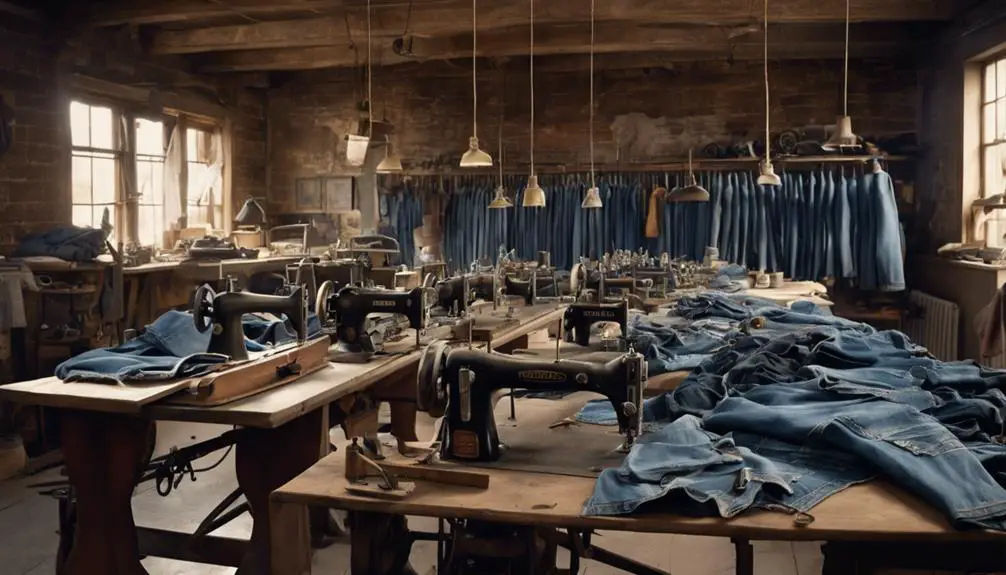
With the introduction of riveted pants in the 1870s, jeans quickly gained traction among workers in various industries. Designed by Levi Strauss and Jacob Davis, these durable workwear pieces were perfect for blue-collar workers like miners and railroad laborers who needed clothing that could withstand tough conditions. The strength of denim and the innovative riveted design made jeans an essential part of their daily attire. In the following decades, denim's versatility would evolve, leading to styles like high-waisted jeans that became popular in the 1980s, enhancing both comfort and fit.
By the early 1900s, jeans had solidified their reputation as reliable workwear, with denim overalls becoming a staple for those in physically demanding jobs. The ruggedness of jeans appealed particularly to those in the American West, where cowboys and farmers embraced them for their practicality and durability.
As the 1920s rolled around, the popularity of jeans surged, reflecting their essential role in the working class. This adoption marked the beginning of jeans' journey from functional clothing to a symbol of American culture. While initially designed for labor, they began paving the way for what would eventually become casual wear, setting the stage for their future evolution in both style and social significance.
Cultural Shifts in the 20th Century
As you explore this era, you'll notice key influences on jeans and their cultural significance:
- The 1930s introduced jeans to Eastern markets during the dude ranch craze. This period also marked the beginning of denim's evolution into casual wear, paving the way for future styles.
- World War II transformed jeans from workwear to leisurewear, enhancing their appeal and leading to the popularity of baggy silhouettes that characterized later decades.
- By the 1960s, college students adopted jeans as their unofficial uniform, symbolizing resistance against societal norms.
- The 1970s featured flared and bell-bottom styles, reflecting new fashion trends and self-expression.
These shifts illustrate how jeans evolved beyond mere clothing to represent individuality and cultural identity. So, next time you slip into your favorite pair, remember the rich history that shaped them into the iconic symbol they are today!
Fashion Transformations Over Decades
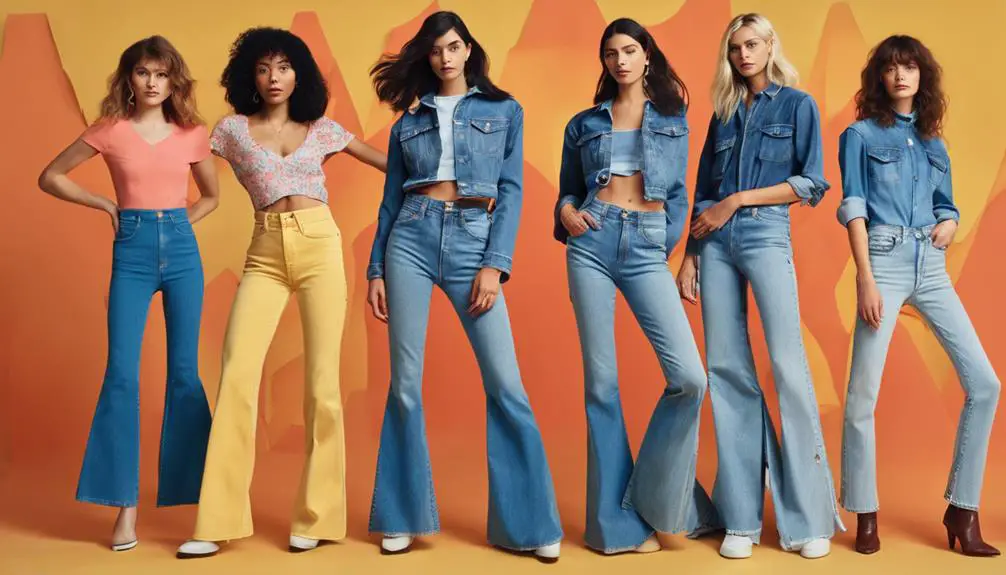
As you explore the evolution of jeans over the decades, you'll notice how they've transformed from rebellious staples in the 1950s to symbols of grunge in the 1990s. The history of iconic brands like Wrangler showcases how denim has adapted to cultural shifts, with vintage pieces often reflecting the craftsmanship and storytelling of their time, especially through vintage logo identification. In the 1970s, flared styles emerged, showcasing a vibrant mix of fashion creativity and personal expression. Each decade brought new influences that shaped denim's place in culture, making it a timeless wardrobe essential for every generation.
Denim in the 1950s
In the 1950s, denim became a powerful symbol of youth rebellion, capturing the spirit of a generation keen to break away from tradition. Blue jeans, once considered mere workwear, transformed into a fashion statement thanks to Hollywood icons like James Dean and Marlon Brando. Their on-screen personas embraced defiance, making jeans a staple of the casual wardrobe.
The cultural shift was palpable, as denim gained popularity amid the rise of rock 'n' roll music. Fashion magazines like Vogue began promoting the "Western chic" look, recognizing jeans' appeal among teenagers. However, schools and public places often banned them, associating jeans with nonconformity.
Here are some key highlights of denim in the 1950s:
- James Dean and Marlon Brando made blue jeans iconic.
- Rock 'n' roll artists embraced the rebellious denim aesthetic.
- Fashion magazines began showcasing jeans as trendy.
- Denim sales surged as Americans adopted jeans widely.
- The decade marked a significant cultural shift in clothing preferences.
Through these influences, denim solidified its status as a timeless emblem of youthful defiance, paving the way for future generations to express themselves through fashion.
1970s Style Evolution
The evolution of denim style over the decades reflects broader cultural shifts and individual expression. Starting in the 1950s, jeans transformed from practical workwear into a fashion staple, symbolizing rebellion, especially among youth influenced by icons like James Dean and Elvis Presley. By the 1960s, jeans became a canvas for individuality during college protests, with zippers replacing button flies for a sleek, modern look.
The 1970s brought flared and bell-bottom styles, driven by disco culture and a surge in customization trends, allowing you to express your creativity through denim. Entering the 1980s, designer jeans took center stage, with brands like Calvin Klein and Armani introducing high-end options that elevated the denim experience. Stone-washing techniques also gained popularity, making jeans even more desirable.
As we moved into the 1990s, baggy jeans and distressed denim emerged, influenced by grunge and hip-hop movements. Oversized fits became the dominant style, reflecting a sense of comfort and casualness that resonated with a generation. This style evolution not only showcased the versatility of jeans but also highlighted the ongoing dialogue between fashion and personal identity.
1990s Grunge Influence
Grunge culture of the 1990s revolutionized denim fashion, pushing aside the sleek, form-fitting styles of the previous decade. Embracing an anti-establishment attitude, the grunge movement favored baggy jeans, often paired with oversized flannel shirts and combat boots. Icons like Kurt Cobain and the band Nirvana made distressed and thrifted denim essential for youth culture, promoting a look that celebrated comfort and individuality.
As this aesthetic took off, high-profile fashion brands began to embrace the grunge influence, leading to a rise in styles such as JNCO jeans and low-slung fits. The era marked a significant shift in denim, allowing for personal expression through:
- Baggy jeans that prioritize comfort
- Distressed denim for a worn-in vibe
- Thrifted denim, perfect for an authentic look
- Customization with patches and paint
- DIY modifications to create unique pieces
The 90s established denim not just as clothing, but as a canvas for artistic expression. As you explore this transformative decade, remember that the grunge movement championed a style that was all about being true to yourself, making it as relevant today as it was then.
Key Denim Facts and Statistics
Exploring the world of denim reveals some fascinating facts and statistics that highlight its impact on fashion and the environment. Did you know that just one bale of cotton can produce enough fabric for approximately 325 pairs of jeans? This efficiency underscores the crucial role cotton plays in denim production. The term "jeans" became widely popular in 1950, marking a pivotal shift in consumer language and fashion trends.
Today, the global jeans market is booming, with U.S. jeans sales projected to reach around $18.4 billion by 2023, showing just how much you love this iconic fabric. However, it's important to contemplate the environmental impact; the average pair of jeans uses about 3,479 liters of water throughout its lifecycle, raising significant concerns about water consumption in denim manufacturing.
On the luxury side, the most expensive jeans ever sold went for a staggering $250,000, demonstrating the potential for high-value items in the denim fashion world. These facts and figures not only capture the history and evolution of jeans but also invite you to reflect on the sustainability practices within the industry today.
Manufacturing Processes Explained
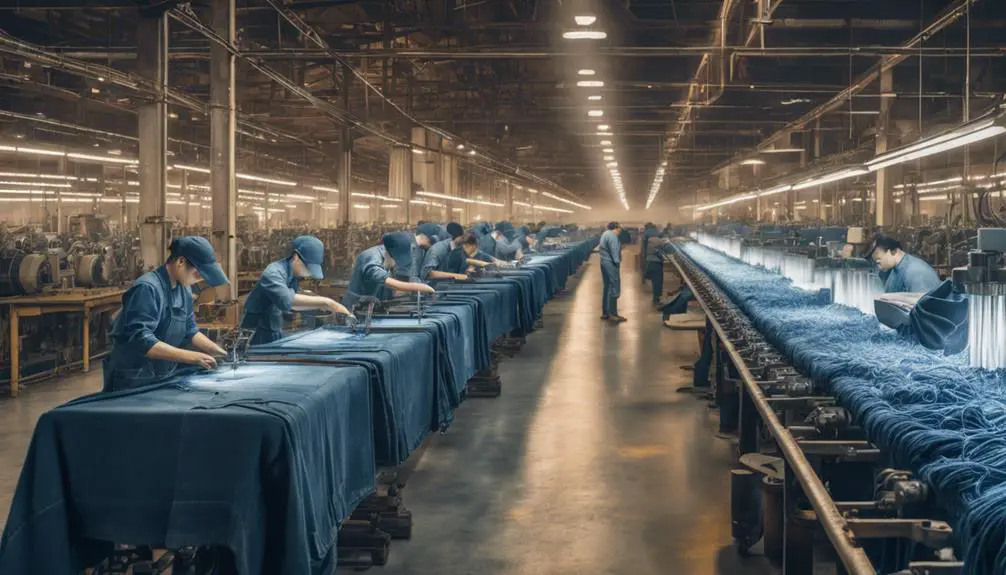
When you immerse yourself in the manufacturing processes behind jeans, you'll discover a fascinating blend of tradition and innovation. The journey starts with denim, a durable cotton twill fabric crafted through a unique weaving technique that intertwines colored and white threads. Next comes the dyeing stage, where indigo transforms the fabric into that iconic blue we all love.
Here's a quick overview of the key steps in the manufacturing process:
- Weaving: Creating the denim fabric with a specific technique.
- Dyeing: Applying indigo dye to give jeans their classic look.
- Cutting: Shaping the fabric into patterns for various styles.
- Stitching: Assembling the pieces together for a perfect fit.
- Adding Copper Rivets: Reinforcing stress points for enhanced durability.
Once the jeans are sewn, quality control kicks in to guarantee they meet durability standards. Techniques like pre-shrinking and distressing are employed to improve appearance and fit. Zippers have largely replaced button flies since the 1960s, adding convenience and functionality to modern jeans. By understanding these processes, you gain a deeper appreciation for the craftsmanship that goes into each pair of jeans you wear.
The Impact of Distressed Denim
Distressed denim isn't just a fashion statement; it represents a cultural rebellion that emerged prominently in the 1990s, influenced by punk and grunge movements. You'll find that this style's origins can be traced back to the 1930s, but it gained major traction when high-end brands started marketing these rugged looks as "vintage" in the 1980s. Today, wearing distressed jeans allows you to express individuality, showcasing a unique flair that stands out against the backdrop of mass-produced fashion.
Origins of Distressed Denim
The rise of distressed denim marked a pivotal moment in fashion history, driven by a desire for individuality and self-expression. Originating in the 1970s, this trend reflected the cultural tides influenced by the punk movement. By the 1980s, the intentional distressing process became a craft, with artists employing techniques like sanding, brushing, and chemical treatments to create unique styles. This early commercialization, sparked by a retailer washing jeans for a worn effect in 1965, laid the groundwork for future fashion innovations.
As the 1990s rolled in, distressed denim gained mainstream popularity, with high-end brands seizing the opportunity to cater to an increasing consumer demand for distinct aesthetics. Distressed denim became more than just a fashion choice; it represented a lifestyle that appealed to diverse demographics.
Here are some key features of distressed denim:
- Rugged appearances that flaunt a casual vibe
- Natural fading patterns that tell a story
- Techniques that allow for endless creativity
- A blend of comfort and rebellion
- Unique styles that stand out in a crowd
This aesthetic continues to resonate, making distressed denim a fashion staple today.
Cultural Rebellion and Identity
Amidst shifting cultural landscapes, distressed denim emerged as a powerful symbol of rebellion and identity. Born from the punk movement in the 1970s, this fashion trend allowed you to express your individuality and anti-establishment sentiments. Artists and musicians began customizing jeans, intentionally creating wear patterns that told stories of their struggles and defiance. By the 1990s, distressed denim transcended its subcultural roots, becoming a staple in mainstream fashion, embraced for its casual yet expressive aesthetic.
The cultural significance of distressed jeans lies in their ability to convey authenticity and a sense of nonconformity. Every pair showcases unique wear patterns, reflecting personal journeys and individual stories. Wearing distressed denim isn't just about style; it's a declaration of self-expression, aligning with the ongoing pursuit of individuality in a world that often values conformity.
As contemporary fashion continues to reinterpret distressed denim, it remains a potent emblem of cultural rebellion. Whether you're rocking a pair at a concert or in your daily life, distressed jeans invite you to embrace your true self, celebrating the beauty of imperfection and the power of personal storytelling in our ever-evolving society.
Fashion Industry Influence
In the wake of the punk and grunge movements, distressed denim transformed from a countercultural symbol into a powerful fashion statement that greatly influenced the industry. This shift began in the 1980s, when intentional distressing techniques like stone-washing and chemical fading made jeans look pre-worn. High-end fashion designers, such as Diesel and Calvin Klein, capitalized on this trend in the 1990s, driving mainstream acceptance and skyrocketing sales.
Today, distressed jeans have become a staple in casual wear, offering styles that showcase individuality and personal expression. Consider these facets of distressed denim's impact:
- Reflects Individuality: Each distressed pair tells a unique story.
- High-End Influence: Designers incorporate distressed elements into luxury collections.
- Mainstream Acceptance: Everyone wears distressed jeans, from celebrities to everyday folks.
- Sustainable Practices: Brands now offer vintage and upcycled options, catering to eco-conscious consumers.
- Versatile Fashion Statement: They work well in various settings, from casual outings to trendy gatherings.
As distressed denim continues to thrive, it exemplifies how fashion evolves, blending style with sustainability and self-expression.
Consumer Behavior Trends
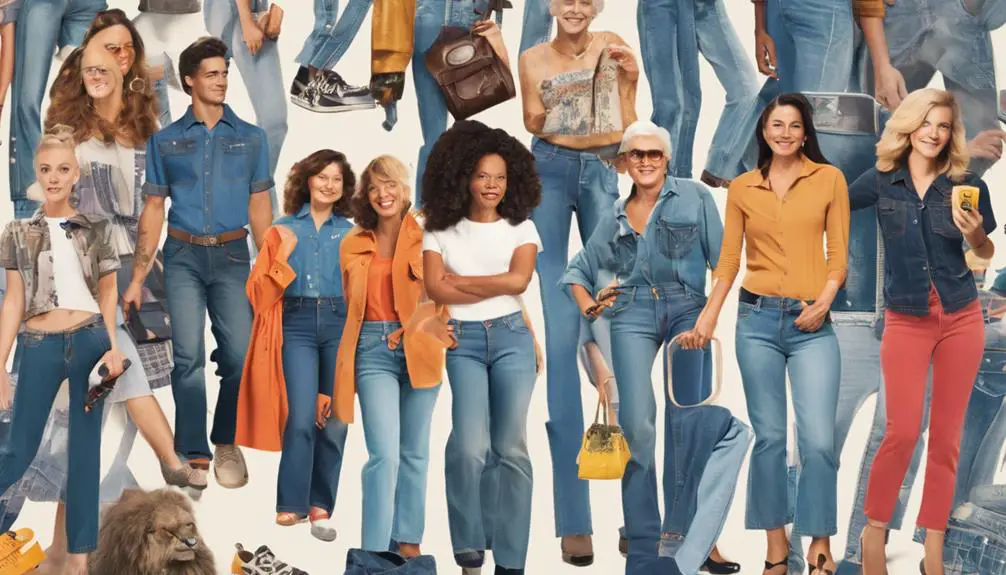
A significant shift in consumer behavior has emerged in the denim market, reflecting changing attitudes toward fashion and sustainability. Jeans sales have skyrocketed, with projections estimating a rise from $13.8 billion in 2011 to $18.4 billion by 2023, showcasing the strong market demand for denim. Many consumers are now prioritizing brand loyalty influenced by sustainability concerns, leading them to seek vintage jeans and second-hand options as part of a more conscious shopping approach.
You might have noticed the growing trend of wearing jeans multiple days before washing, which aligns with efforts to reduce environmental impact and maintain fabric quality. Distressed denim, once a hallmark of the punk and grunge movements in the 1990s, has returned, driving you to explore unique and personalized styles. Comfort is also a top priority now, as relaxed fits and high-waisted styles have become favorites among shoppers, reflecting lifestyle changes.
This evolving consumer behavior indicates a deeper connection to fashion, where style and sustainability go hand in hand, ensuring that your denim choices resonate with both personal identity and environmental responsibility.
Legal and Environmental Considerations
When you think about jeans, it's easy to overlook the legal and environmental aspects tied to their production. The fashion industry faces scrutiny for not only its heavy water usage but also for practices that can endanger workers' health, sparking important conversations about sustainability and ethics. As you explore the history of jeans, keep in mind how legal precedents and environmental impacts shape the denim we wear today, driving a shift toward more responsible choices in fashion.
Legal Precedents and Fashion
Although fashion often reflects personal identity, its intersection with legal issues, particularly concerning jeans, raises significant questions about societal norms and consent. The infamous 1992 Italian rape trial revealed how clothing, like tight jeans, was controversially cited as evidence of consent. This led to a significant 1998 Supreme Court ruling emphasizing that consent is independent of attire. Legal cases involving jeans have sparked important discussions about societal perceptions and cultural biases within the justice system.
Consider these points when reflecting on the legal landscape surrounding jeans:
- Fashion choices, including jeans, express personal identity and autonomy.
- Victim-blaming often stems from misguided perceptions of clothing.
- Legal reforms are necessary to combat cultural biases in judicial outcomes.
- The public outcry from the Italian case fueled advocacy for women's rights.
- Understanding consent is fundamental, regardless of what someone wears.
As conversations evolve, it's fundamental to recognize that the intersection of fashion, consent, and societal perceptions shapes legislative frameworks. Your jeans aren't just a style statement; they carry significant cultural weight that can influence legal outcomes and societal attitudes.
Environmental Impact of Production
The legal discussions surrounding jeans extend beyond societal perceptions of consent to encompass significant environmental concerns linked to their production. You might be surprised to learn that producing a single pair of jeans can use up to 3,479 liters of water throughout its lifecycle! This staggering figure highlights the environmental challenges associated with denim manufacturing. Fortunately, modern techniques have emerged to reduce water usage and lessen the overall impact on our planet.
However, ethical concerns have also prompted essential changes in the industry. For instance, the practice of sandblasting jeans, once popular for creating that trendy distressed look, is now banned by several companies due to the serious health risks it poses to workers. As consumer awareness grows regarding both humanitarian and environmental impacts, brands are increasingly focusing on sustainable practices, such as using eco-friendly materials and innovative recycling methods.
Frequently Asked Questions
Who Invented Jeans and Why?
You'll find that Levi Strauss revolutionized workwear by creating durable denim pants, sparking a fashion statement. This material innovation led to jeans' cultural impact, global popularity, and diverse style variations while promoting sustainable practices in fashion.
When Did We Start Wearing Jeans?
Jeans journeyed into your wardrobe around the late 19th century. Their denim evolution reflects casual wear's cultural significance, showcasing age demographics, style variations, and seasonal trends while addressing sustainability issues in today's global influence.
What Colour Were Jeans Originally?
Originally, jeans were typically blue, thanks to dye techniques using natural indigo. As denim evolved, fashion trends shifted, introducing colors like black and brown, showcasing textile innovations and color symbolism, reflecting vintage styles and modern variations.
Why Do Farmers Wear Jeans?
You wear jeans for their durability benefits and workwear practicality, reflecting farmer preferences. They symbolize cultural evolution, adaptable to regional styles. Denim types vary, but maintaining them guarantees longevity, making jeans a staple for your lifestyle.
